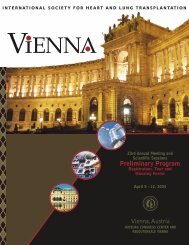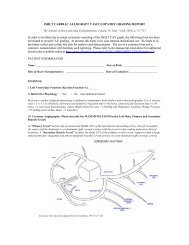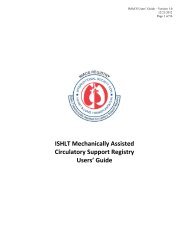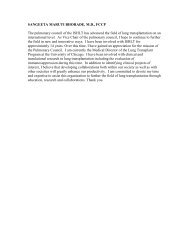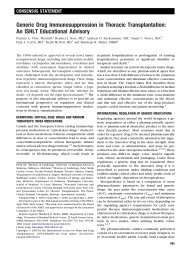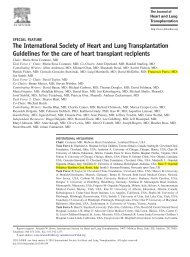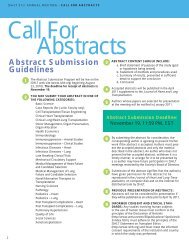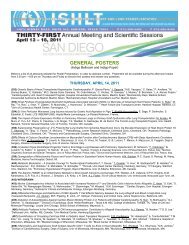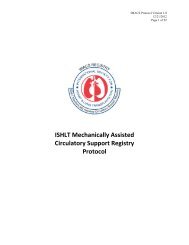Task Force 4: Inpatient Management of Patients with MCSD - The ...
Task Force 4: Inpatient Management of Patients with MCSD - The ...
Task Force 4: Inpatient Management of Patients with MCSD - The ...
You also want an ePaper? Increase the reach of your titles
YUMPU automatically turns print PDFs into web optimized ePapers that Google loves.
<strong>MCSD</strong> surgery is advised. 19 Preoperative skin cleansing <strong>with</strong> chlorhexidine-alcohol is<br />
superior to povidone-iodine in clean-contaminated operations for prevention <strong>of</strong><br />
superficial and deep wound infections. 20<br />
During surgical creation <strong>of</strong> the pocket (if needed) and placement <strong>of</strong> a <strong>MCSD</strong>,<br />
organisms may be inoculated and later cause infection. <strong>The</strong>refore, it is crucial to follow<br />
meticulous antiseptic techniques in the operating room. HEPA filters and laminar air<br />
flow in the operating room is suggested to maximize sterile ventilation. 21 Movement <strong>of</strong><br />
personnel should be restricted, and people present in the operating room should use<br />
double gloving and headgear to completely cover their hair. 21 Antibiotic-soaked pads<br />
should cover the pump and cannulas, and the pump should be extracted from its sterile<br />
packing shortly before its placement in the pocket, 21 in order to minimize potential<br />
contamination. Adequate hemostasis is important since hematomas may serve as<br />
culture media for bacteria. Irrigation <strong>of</strong> the mediastinum <strong>with</strong> antibiotic solutions<br />
(vancomycin and gentamicin) is performed before wound closure. 21<br />
Post-Operative Routine Prophylaxis. Antibiotic prophylaxis beyond 48 hours<br />
after surgery is generally unnecessary. 22 Some centers continue prophylaxis until chest<br />
tubes are removed, or in the setting <strong>of</strong> delayed chest closure. Prolonged use <strong>of</strong><br />
vancomycin in high-risk general cardiac surgery patients was not beneficial in reducing<br />
infection. 23 Also, in a retrospective study, decreasing the duration <strong>of</strong> vancomycin<br />
prophylaxis by more than half was not associated <strong>with</strong> an increase in infection rate after<br />
<strong>MCSD</strong> placement. 24 <strong>The</strong> use <strong>of</strong> nasal mupirocin to reduce MRSA colonization and<br />
secondarily reduce staphylococcus infection is practiced by many centers. 25,26 <strong>The</strong><br />
optimal regimen for antibiotic prophylaxis in patients undergoing <strong>MCSD</strong> placement is<br />
not known, but many centers use a combination <strong>of</strong> intravenous vancomycin, rifampin,<br />
lev<strong>of</strong>loxacin, and fluconazole as recommended in the REMATCH trial. 27,28 An important<br />
consideration to take into account is the antibiotic resistance-pr<strong>of</strong>ile <strong>of</strong> organisms in the<br />
medical center performing the <strong>MCSD</strong> implant .<br />
Secondary prophylaxis given for procedures (dental, respiratory, genitourinary,<br />
gastrointestinal) have not been studied in <strong>MCSD</strong> recipients. In general, prophylaxis has<br />
not been recommended for cardiac patients except in certain high risk groups such as<br />
those <strong>with</strong> prosthetic valves, forms <strong>of</strong> congenital heart disease, and <strong>with</strong> valvulopathy<br />
9





